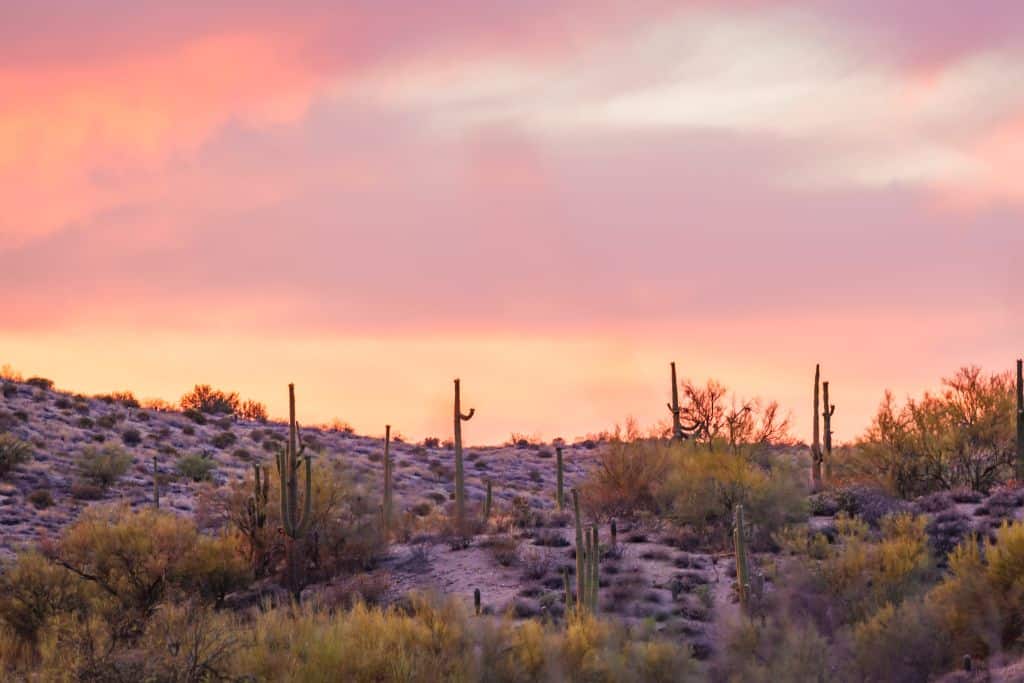As we approach another month of summer, heatwaves in the US persist, mostly in Southern states. Arizona’s capital Phoenix has seen record-breaking temperatures for a whopping 31 consecutive days last month, prompting authorities to issue excessive heat warnings in the state. While residents are struggling to beat the heat, there has also been another rather unexpected victim: cactuses.
—
Phoenix’s Climbing Temperatures
The National Weather Service in Phoenix reported that the region experienced 31 consecutive days of temperatures above 43.3C (110F) for the month of July. Despite temperatures dropping slightly, the city continues to hold an Excessive Heat Warning issued by the National Weather Service.
According to the National Oceanic and Atmospheric Administration (NOAA), the average temperature last month was 42.2C (108F), the highest ever recorded in the state, beating last year’s record of 39.4C (1-3F) for July.
Additionally, this summer has yielded some of Phoenix’s highest temperatures of all time. For example, July alone has set 12 new daily records for the highest temperatures, with the mercury reaching up to 48.3C (119F).

July temperature ranges exceed the normal range and peaked at the red zone in the graph. Image: National Weather Service.
The extreme heat has led to numerous heat-related health issues in the state of Arizona. Arizona Department of Health Services reported that the number of patients with heat-induced emergency illnesses increased from 1,928 patients in 2018 to 2,462 patients in 2022.
However, one peculiar event has been unraveling since last month, setting this year’s summer apart from previous ones. Cactuses, plants that are known for flourishing in arid climates, have been dying en-masse in Phoenix’s desert lands. The cause of their demise is no mystery – they simply cannot handle the extreme heat.
Friend Turned Foe: How the Heat Is Killing Cactuses
Although cactuses favour heated conditions, too much heat had proven to be deadly for them. As temperatures continue to spike, much-needed rainfall has failed to show up for the crops, prompting the health decline of many cactuses in Phoenix. Last month, no precipitation was recorded in the capital city, according to NOAA Online Weather Data.
“These plants are adapted to this heat, but at some point the heat needs to cool down and the water needs to come,” Desert Botanical Garden’s research scientist Tania Hernandez told Firstpost.
A 2022 peer-reviewed study by Nature Plants revealed 60-90% of all cactus species assessed are expected to be negatively impacted by climate change and other anthropogenic processes. In this case, the combination of scorching heat and absent rainfall is the perfect formula for the cactuses’ demise.
Sophia Booth, landscape designer at Moon Valley Nursery, told the AP that people from across the city have called and noted that their cactuses were “yellowing really hard, fell over or [had] broken arms.”
Cactuses exercise their vital flora activity at night, when they open up their stomata to conduct respiration. This is crucial for their photosynthesis process during the day, where they take in the atmosphere’s carbon dioxide. Additionally, with a lack of water in their systems, cactuses lose rigidity and structure. They ultimately will turn soft and fall.
Since Phoenix’s extreme heat extends to the night, the cactuses suffocate and get “stressed out,” making them vulnerable to infections and insects.
As an extremely arid city, Phoenix is the perfect home for cactuses. The Desert Botanical Garden holds more than 1,000 saguaro cactuses, making it one of the most iconic cactus species in the city. While this species can live up to 200 years, many of those aged between 40 and 80 years old have perished from the heat.
Heatwaves have grown rampant in the US over the past four weeks, with temperatures reaching unprecedented levels for extended periods of time. El Paso, Texas, experienced 42 consecutive days of temperatures above 37.7C (100F), while Miami recorded 46 consecutive days of temperatures above the same mark.
Since Phoenix’s 31-day streak of temperatures above 43.3C (110F) has finally ended, hopes for the approaching rainfall to ease the heat intensity have reignited. Nonetheless, the downpours will only act as a temporary fix to the long-term effects of climate change and heatwaves, as the global warming crisis continues to intensify every summer.
You might also like: Top 6 Environmental Issues the US Is Facing in 2023


















